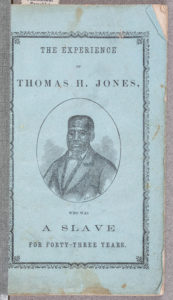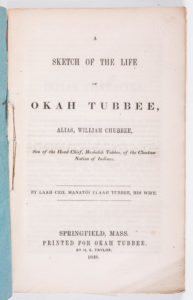Black Self-Publishing is a new collaborative research project from the American Antiquarian Society. The core of this site consists of a list I developed of books self-published by black authors within the scope of the American Antiquarian Society’s collecting period (origins to 1876). Studying self-publishing, occasions when an author pays for the printing of his or her text, opened a window into the world of early African American print, revealing both a diversity of genres and authorial motivations for publishing. Although the narratives of Fredrick Douglass or Harriet Jacobs are probably the most popular to readers today, self-published texts by black creators compiled in this project encompass everything from a hotel-keeping manual to a speech on the “larceny of dogs.”
 The project on self-published African American titles started as a spreadsheet and finished as an online exhibit using Omeka. By presenting this working list on a prototype site, AAS hopes to encourage new forms of collaboration among scholars, students, community members, bibliographers, teachers, and more. (Watch this video to see how you might engage with this project!)
The project on self-published African American titles started as a spreadsheet and finished as an online exhibit using Omeka. By presenting this working list on a prototype site, AAS hopes to encourage new forms of collaboration among scholars, students, community members, bibliographers, teachers, and more. (Watch this video to see how you might engage with this project!)
Within my first few weeks at AAS, I received a crash course on the history of printing in America and was amazed at the complexity of the printing process: making paper, setting the type, inking and pressing sheets, and sewing together the pages. I began to learn how to analyze the materiality of a book. During my internship, I examined chain lines (the prominent, wide-spaced, parallel lines in laid paper), gatherings (a group of folded sheets), and the slightest break in a letter on the page. At times, I felt like a slightly obsessive printing detective, solving historical mysteries while bending over books with a tape measure to compare the height of letters, excited about my type spacing discoveries.
AAS’s emphasis on the history of printing also contributed to my research. One of my greatest triumphs was uncovering the identity of the mysterious “Enterprising Publishing Company” listed on the imprint of several books on my list. Were they really a publishing company? I was determined to find out. After looking with no success in lists of newspapers, I made a breakthrough using Readex’s African American Newspaper database through the AAS website: I discovered that the Enterprise Publishing Company was the only black job printing office in Washington, D.C., from 1876 to 1881. Their claim that “that colored printers are the ‘boss’” remains one of the most memorable quotes from my summer.
Other special finds (seen below) include The Experience of Rev. Thomas H. Jones, Who Was a Slave for Forty-Three Years (1868), A Sketch of the Life of Okah Tubbee (1848), and Lunsford Lane; Or, Another Helper from North Carolina (1863).
When my supervisor Elizabeth Pope and I journeyed over to the section in the reading room for bibliographies on Afro-Americana, I received a big shock. While Elizabeth showed me a bibliography for black writers related to the military, a bibliography of black New England writers, and a list of titles held by the Library Company of Philadelphia, I wondered why the bibliographies on Afro-Americana were so sparse and specific. (The methodology section of website lists the sources I consulted for the Black Self-Publishing site.) Although important work has been done on the topic, especially by black bibliographers in the early twentieth century, the deeper I researched into this project, the more I wished for a complete bibliography of Afro-Americana to guide my research. What I was able to pull together over one summer is nowhere near a complete bibliography, but I hope this project serves as another resource that leads towards a more complete and accurate account of books published by black authors. (A larger bibliographical project on all Black authors is now being undertaken by the Black Bibliography Project based at Rutgers and Yale.)
As I read more bibliographies and added their findings to my list, I became more familiar with the names of many early African American writers. I picked several to research further, and, after a short time, they began to feel like good friends. Looking into the stories of these authors was one of my favorite parts of the project; their stories were fascinating, and it felt like I was able to contribute to scholarly knowledge using the editions of their books at AAS. One author, the spiritualist medium Paschal Beverley Randolph, who prolifically self-published books for 20 years, started to feel like he was following me around. Serendipitously, when I visited with a book dealer in Connecticut, Randolph’s book was the first I pulled off the shelf. And, even better, it was one AAS didn’t have in its collections!
The summer was full of exciting discoveries, from locating books to add to my list to closely working with the AAS collection. I’m excited to see how the black self-publishing project will be used in the future, and I’m so grateful for everything that my summer at AAS has taught me.
In the summer of 2018, Sadie Van Vranken was an intern at the American Antiquarian Society as part of the Princeton Internship in Civic Service (PICS) program from Princeton University. She created an Omeka website about self-publishing by early American black authors that incorporated her own research with that of others.




